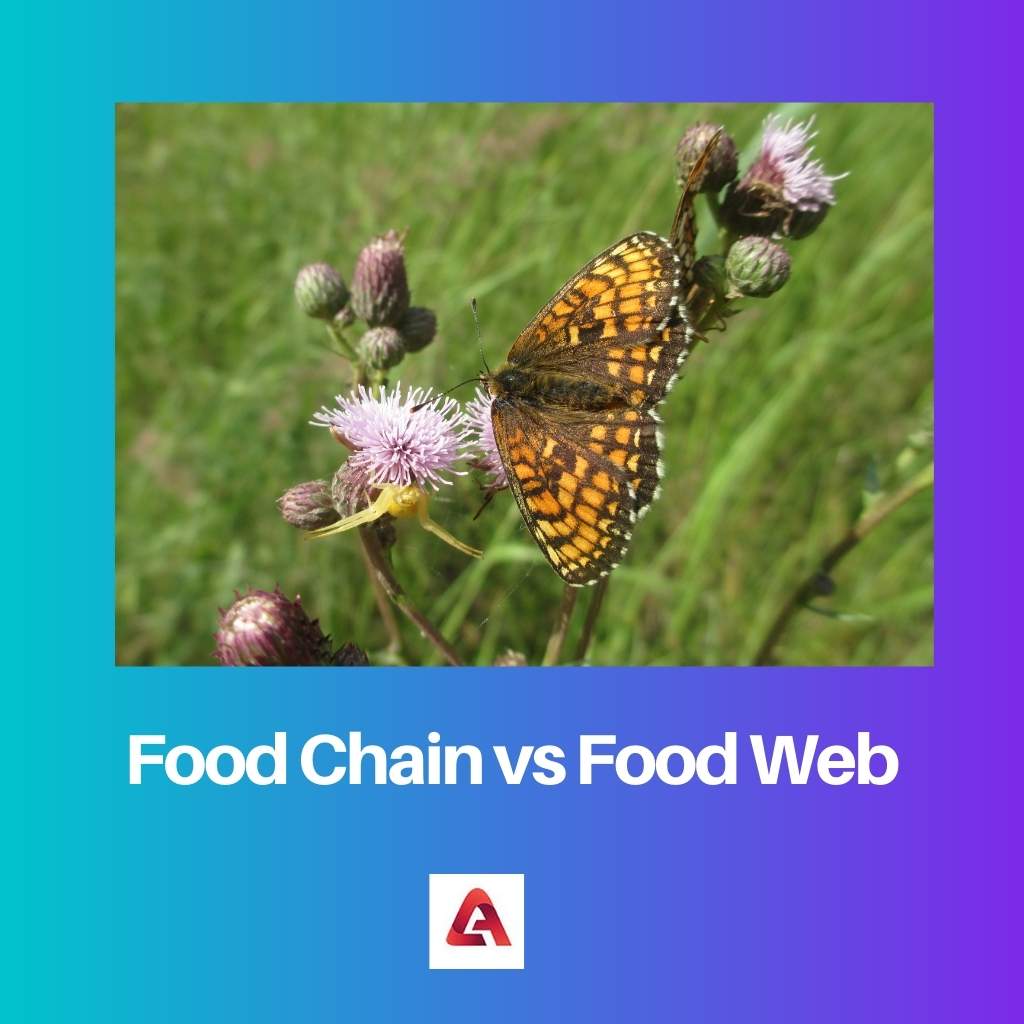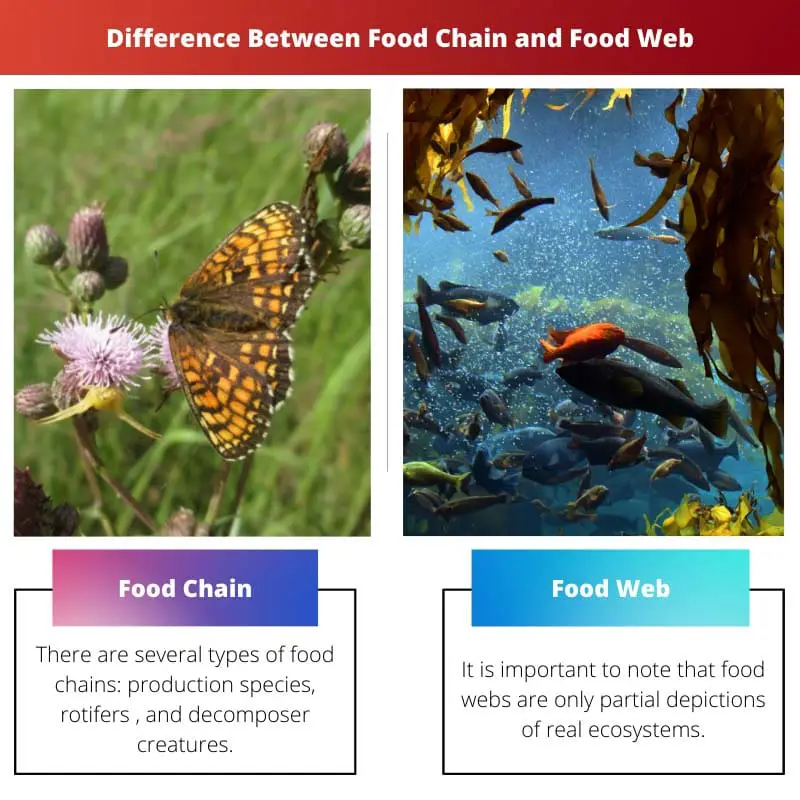When it comes to feeding any species in any habitat, there is just one thing that matters: energy. Energies can travel in a variety of directions, and the types of directions rely on several other elements.
A food chain, as well as a food web, is defined by how organisms utilize this resource and the routing energy follows from one creature to another.
Key Takeaways
- A food chain shows a linear relationship between organisms and their food sources, while a food web shows a complex network of relationships between multiple organisms and their food sources.
- A food chain is a simplified version of a food web, while a food web provides a more realistic representation of the interactions between organisms.
- A change in one part of a food web can have far-reaching effects on other parts, while a change in one part of a food chain has a more limited impact.
Food Chain vs Food Web
The food chain is a linear network of links that starts from the producer organisms and ends at the apex predator or decomposer species, showing how organisms are related by the food they eat. A food web is a graph and natural interconnection of all the food chains in a single ecosystem.

There are several types of food chains: production species (such as grass or shrubs that use solar energy to manufacture their sustenance), rotifers (such as insects or millipedes), and decomposer creatures (such as fungi or bacteria).
There is a trophic level for each rung of the food chain in the ecosystem.
It is important to note that food webs are only partial depictions of real ecosystems because they must coarse many life forms into trophic taxa or workable groups of organisms that share predators and pounce in the food web.
Comparison Table
| Parameters of Comparison | Food Chain | Food Web |
|---|---|---|
| Energy Flow | A Food Chain is an energy transfer diagram in the form of a straight line. | On the other hand, the energy flow is depicted by multiple connections in a food web. |
| Feeding Process | A higher-level trophic species relies on a lower-level trophic creature in a food Chain. | When an organism rises in the food web, it has more accessibility to resources that are available to those at a below trophic level. |
| Effect on Organisms | Food Chain has almost no impact on the flexibility and efficiency of organisms. | Food web contributes to an organism’s increased flexibility and efficiency. |
| Effect on Stability | A Food Chain exacerbates an ecosystem’s fragility. | On the other hand, a food web improves the ecosystem’s sustainability. |
| Pathway | To describe the linear movement of food molecules and the grazing interactions between creatures in an ecosystem, food chain uses trophic levels and shows them in series. | Whereas, food web is a visual representation of how food chains intertwine in a specific environmental region. |
What is Food Chain?
There are several types of food chains: production species (such as grass or shrubs that use solar energy to manufacture their sustenance), rotifers (such as insects or millipedes), and decomposer creatures (such as fungi or bacteria).
There is a trophic level for each rung of the food chain in the ecosystem.
Most organisms depend on food chains to survive. Occasionally, removing just one ingredient from the food supply chain might cause a species to go extinct.
First-tier farmers form the basis of the food chain. Because higher trophic levels can’t use energy from sunlight or inanimate chemical substances, they must devour providers or other organisms that ingest producers.
Almost all life would come to an end if the sunlight vanished, as its light is required for photosynthesis. Dead animal-consuming organisms convert organic molecules into simple nutrients that are buried in the ground.
For plants to produce organic substances, they need basic nutrients. And over 100,000 distinct decomposers are thought to exist.

What is Food Web?
It is important to note that food webs are only partial depictions of real ecosystems because they must coarse many life forms into trophic taxa or workable groups of organisms that share predators and pounce in the food web.
In quantification (or arithmetical portrayal) concepts of trophic or consumer-resource explicit measures, environmentalists use these approximations to reduce complexity.
To test for generalized trends in real food web networks, individuals can use these models.
Within the hierarchical model of food webs, conservationists have discovered properties that are not random. Meta-analyses rely on publication examples that are of varying quality and contain omissions.
Despite this, the number of research studies on com has increased dramatically.
The trophic levels and placements of food webs can be determined. In the first layer are just the fundamental species, like plants, which are resource-limited and eat nothing else on the web.
There are a variety of basal species, comprising autotrophs, decomposers, and disintegrating biological matter and its accompanying microbes, which were characterized as detritus and vasculature plant matter.

Main Differences Between Food Chain and Food Web
- A Food Chain is an energy transfer diagram in the form of a straight line. On the other hand, the energy flow is depicted by multiple connections in a food web.
- A higher-level trophic species relies on a lower-level trophic creature in a Food Chain. When an organism rises in the food web, it has more access to resources that are available to those at a below-trophic level.
- The Food Chain has almost no impact on the flexibility and efficiency of organisms. The Food web contributes to an organism’s increased flexibility and efficiency.
- A Food Chain exacerbates an ecosystem’s fragility. On the other hand, a food web improves the ecosystem’s sustainability.
- To describe the linear movement of food molecules and the grazing interactions between creatures in an ecosystem, the food chain uses trophic levels and shows them in series. In contrast, the food web is a visual representation of how food chains intertwine in a specific environmental region.




